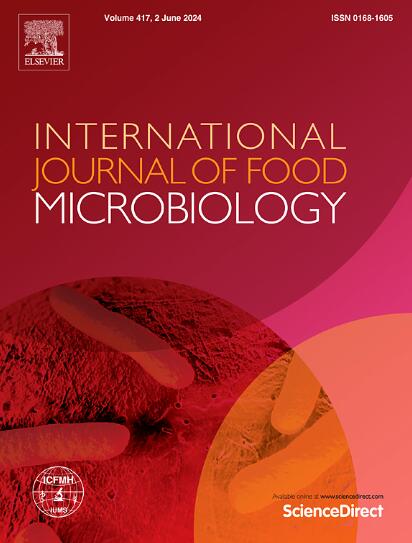Evaluation of commercially available produce antimicrobial washes to improve the quality and microbial safety of fresh produce
IF 5
1区 农林科学
Q1 FOOD SCIENCE & TECHNOLOGY
International journal of food microbiology
Pub Date : 2025-06-12
DOI:10.1016/j.ijfoodmicro.2025.111318
引用次数: 0
Abstract
Despite ongoing efforts to mitigate foodborne pathogen contamination, outbreaks associated with the consumption of fresh produce persist. This research evaluated the efficacy of three sanitizers in reducing various microorganisms on the surfaces of fresh cucumbers, broccoli, and lettuce under retail crisping conditions. Specifically, this study examined the ability of peracetic acid (PAA; 80 mg/L), hypochlorous acid (FAC; 50 mg/L free available chlorine), and accelerated hydrogen peroxide (AHP; 500 mg/L) to reduce pathogens (0.79–2.41 log CFU/g) and natural microbiota, including aerobic bacteria (0.54–2.55 log CFU/g) and yeasts and molds (0.34–1.58 log CFU/g), when applied for 1 min at both 5 and 25 °C. Results showed that all antimicrobial washes significantly reduced pathogens at both temperatures (p < 0.05). Cucumbers treated with the washing solutions exhibited a greater reduction in E. coli O157:H7 (up to 3.72 log CFU/g), S. typhimurium (up to 2.07 log CFU/g), and aerobic bacteria (up to 2.55 log CFU/g) compared to broccoli and lettuce (p < 0.05). This study also investigated the sanitizers' ability to prevent cross-contamination during the retail crisping process of lettuce heads (contact time: 1.5, 3, and 5 min). PAA and FAC significantly reduced cross-contamination with E. coli O157:H7 and S. typhimurium after 3 min of immersion. PAA also significantly reduced L. monocytogenes cross-contamination in batch 2 after 3 min of contact time (p < 0.05). In contrast, immersion of lettuce heads in water alone (WTC) was ineffective at reducing foodborne pathogens and cross-contamination risks. Highlighting the significance of postharvest antimicrobial washes in reducing the contamination and cross-contamination of fresh produce with foodborne pathogens at the retail level.
对市售农产品抗菌洗涤液进行评价,以提高新鲜农产品的质量和微生物安全性
尽管正在努力减轻食源性病原体污染,但与食用新鲜农产品有关的疫情持续存在。本研究评估了三种消毒剂在零售脆皮条件下减少新鲜黄瓜、西兰花和生菜表面各种微生物的功效。具体来说,本研究检测了过氧乙酸(PAA;80 mg/L),次氯酸(FAC;50 mg/L游离有效氯)和加速过氧化氢(AHP;500 mg/L),在5°C和25°C下作用1分钟,可减少病原体(0.79-2.41 log CFU/g)和天然微生物群,包括需氧细菌(0.54-2.55 log CFU/g)和酵母和霉菌(0.34-1.58 log CFU/g)。结果显示,在两种温度下,所有抗菌洗液都能显著减少病原体(p <;0.05)。与西兰花和生菜相比,用洗涤液处理的黄瓜显示出更大的大肠杆菌O157:H7(高达3.72 log CFU/g),鼠伤寒沙门氏菌(高达2.07 log CFU/g)和好氧细菌(高达2.55 log CFU/g)的减少。0.05)。本研究还调查了杀菌剂在生菜头零售脆化过程中(接触时间:1.5分钟、3分钟和5分钟)防止交叉污染的能力。浸泡3分钟后,PAA和FAC显著降低了与大肠杆菌O157:H7和鼠伤寒沙门氏菌的交叉污染。接触时间3 min后,PAA也显著降低了第2批单增李斯特菌的交叉污染(p <;0.05)。相比之下,生菜头单独浸泡在水中(WTC)对减少食源性病原体和交叉污染风险无效。强调采后抗菌洗涤在减少零售层面新鲜农产品与食源性病原体的污染和交叉污染方面的重要性。
本文章由计算机程序翻译,如有差异,请以英文原文为准。
求助全文
约1分钟内获得全文
求助全文
来源期刊
CiteScore
10.40
自引率
5.60%
发文量
322
审稿时长
65 days
期刊介绍:
The International Journal of Food Microbiology publishes papers dealing with all aspects of food microbiology. Articles must present information that is novel, has high impact and interest, and is of high scientific quality. They should provide scientific or technological advancement in the specific field of interest of the journal and enhance its strong international reputation. Preliminary or confirmatory results as well as contributions not strictly related to food microbiology will not be considered for publication.

 求助内容:
求助内容: 应助结果提醒方式:
应助结果提醒方式:


